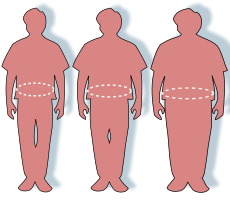Obesity
 |
| Obesity | |
|---|---|
Silhouettes and waist circumferences representing normal, overweight, and obese
| |
Obesity is a medical condition in which excess body fat has accumulated to the extent that it may have a negative effect on health, leading to reduced life expectancy and/or increased health problems.In Western countries, people are considered obese when their body mass index (BMI),a measurement obtained by dividing a person's weight by the square of the person's height, exceeds30 kg/m2, with the range 25-30 kg/m2 defined as overweight. Some East Asian countries use stricter criteria.
Obesity increases the likelihood of various diseases, particularly heart disease, type 2 diabetes, obstructive sleep apnea, certain types of cancer, and osteoarthritis. Obesity is most commonly caused by a combination of excessive food energy intake, lack of physical activity, and genetic susceptibility, although a few cases are caused primarily by genes, endocrine disorders, medications, orpsychiatric illness. Evidence to support the view that some obese people eat little yet gain weight due to a slow metabolism is limited. On average, obese people have a greater energy expenditure than their thin counterparts due to the energy required to maintain an increased body mass.
Dieting and exercising are the main treatments for obesity. Diet quality can be improved by reducing the consumption of energy-dense foods, such as those high in fat and sugars, and by increasing the intake of dietary fiber. With a suitable diet, anti-obesity drugs may be taken to reduce appetite or decrease fat absorption. If diet, exercise, and medication are not effective, a gastric balloonmay assist with weight loss, or surgery may be performed to reduce stomach volume and/or bowel length, leading to feeling full earlier and a reduced ability to absorb nutrients from food.
Obesity is a leading preventable cause of death worldwide, with increasing rates in adults and children. Authorities view it as one of the most serious public health problems of the 21st century. Obesity is stigmatized in much of the modern world (particularly in theWestern world), though it was widely seen as a symbol of wealth and fertility at other times in history and still is in some parts of the world. In 2013, the American Medical Association classified obesity as a disease.
Classification
Obesity is a medical condition in which excess body fat has accumulated to the extent that it may have an adverse effect on health.It is defined by body mass index (BMI) and further evaluated in terms of fat distribution via the waist–hip ratio and total cardiovascular risk factors.BMI is closely related to both percentage body fat and total body fat.
In children, a healthy weight varies with age and sex. Obesity in children and adolescents is defined not as an absolute number but in relation to a historical normal group, such that obesity is a BMI greater than the 95th percentile. The reference data on which these percentiles were based date from 1963 to 1994, and thus have not been affected by the recent increases in weight.
| BMI (kg/m2) | Classification | |
|---|---|---|
| from | up to | |
| 18.5 | underweight | |
| 18.5 | 25.0 | normal weight |
| 25.0 | 30.0 | overweight |
| 30.0 | 35.0 | class I obesity |
| 35.0 | 40.0 | class II obesity |
| 40.0 | class III obesity | |
BMI is defined as the subject's weight divided by the square of their height and is calculated as follows.
 ,
,
- where m and h are the subject's weight and height respectively.
BMI is usually expressed in kilograms per square metre, resulting when weight is measured in kilograms and height in metres. To convert from pounds per square inch multiply by703 (kg/m2)/(lb/sq in).
The most commonly used definitions, established by the World Health Organization (WHO) in 1997 and published in 2000, provide the values listed in the table at right.
Some modifications to the WHO definitions have been made by particular bodies. The surgical literature breaks down "class III" obesity into further categories whose exact values are still disputed.
- Any BMI ≥ 35 or 40 kg/m2 is severe obesity.
- A BMI of ≥ 35 kg/m2 and experiencing obesity-related health conditions or ≥40–44.9 kg/m2 is morbid obesity.
- A BMI of ≥ 45 or 50 kg/m2 is super obesity.
As Asian populations develop negative health consequences at a lower BMI than Caucasians, some nations have redefined obesity; the Japanese have defined obesity as any BMI greater than 25 kg/m2 while China uses a BMI of greater than 28 kg/m2.
Effects on health
Excessive body weight is associated with various diseases, particularly cardiovascular diseases, diabetes mellitus type 2, obstructive sleep apnea, certain types of cancer,osteoarthritis and asthma. As a result, obesity has been found to reduce life expectancy.
source : http://en.wikipedia.org
No comments:
Post a Comment